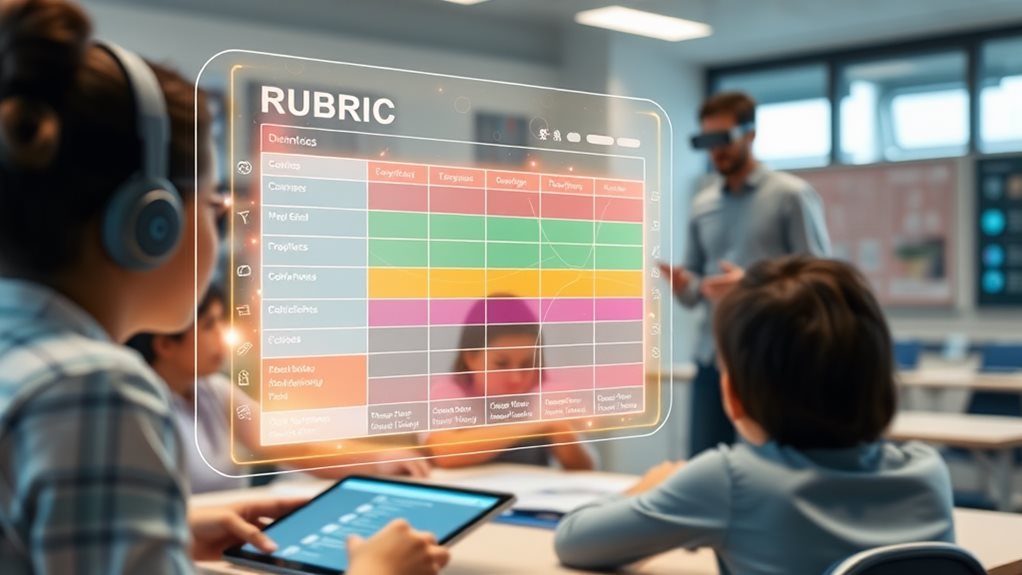The future of rubrics in education focuses on flexibility and personalization. You'll see a shift from rigid criteria to dynamic, competency-based assessments that track skill progression over time. AI integration automates grading and provides tailored feedback, while student-centered co-creation fosters transparency and engagement. These practices ensure equity by accommodating diverse learning styles and expressions of knowledge. As technology evolves, rubrics will adapt to meet evolving learner needs, offering deeper insights into educational outcomes.
The Evolution of Rubric Design

The evolution of rubric design has been a game-changer in education, and if you're not keeping up, you're missing out on transformative tools that can elevate both teaching and learning. Gone are the days of rigid, one-size-fits-all rubrics that only assessed the final product.
Today's rubrics are dynamic, competency-based, and designed to measure skill progression over time. They're no longer just about evaluating what students produce; they're about understanding how students grow.
One of the most significant shifts is the move toward co-creation. Modern rubrics now incorporate student feedback, giving them a voice in the assessment process. This approach fosters educational agency and ensures that expectations are crystal clear. When students help design the criteria, they're more invested in meeting—and exceeding—those standards.
Here's what you need to know about the latest advancements in rubric design:
- Flexibility: Rubrics now adapt to various levels of competency, allowing for personalized learning paths. They're no longer fixed but evolve as students grow.
- Real-Time Analytics: With advancements in AI, rubrics can provide instant data on student performance, helping you identify gaps and adjust instruction on the fly.
- Multiple Performance Levels: Instead of binary pass/fail metrics, rubrics now include nuanced levels like emerging, developing, and mastering, giving you a clearer picture of progress.
Rubrics have also become more inclusive of creativity and deeper learning. They've moved beyond simply checking off tasks to valuing how students apply knowledge in innovative ways. For example, a rubric might assess a student's ability to synthesize information or think critically, rather than just whether they completed an assignment.
Technology has played a pivotal role in this evolution. Learning Management Systems (LMS) now integrate rubric builders that make it easier than ever to create, customize, and share assessments. This accessibility ensures that educators can focus more on teaching and less on administrative tasks.
The key takeaway? Rubrics are no longer static tools—they're living frameworks that reflect the complexities of modern education. If you're still using outdated designs, it's time to rethink your approach. Embrace the evolution, and you'll see a measurable impact on both student engagement and outcomes.
AI Integration in Rubric Assessment
AI integration in rubric assessment is revolutionizing how educators evaluate student performance. You'll notice that traditional rubrics, while effective, often lack the flexibility to adapt to individual student needs. With AI, you can create customizable templates that dynamically adjust based on student data, ensuring evaluations are more relevant and impactful. Imagine a rubric that evolves as students progress, focusing on areas where they need the most improvement. That's the power AI brings to the table.
- AI automates the creation and grading of rubrics, drastically cutting down the time you spend on manual assessments.
- It ensures consistency in grading, reducing biases and standardizing evaluations across diverse classrooms.
- Real-time feedback becomes a reality, allowing students to adjust their work on the fly based on instant, actionable insights.
For example, picture a student working on a research paper. An AI-enhanced rubric could analyze their draft, flagging areas like thesis clarity or citation accuracy in real time. This immediate feedback loop not only accelerates learning but also fosters a more engaging and responsive educational experience.
AI-driven data analytics also elevate the accuracy of assessments. By analyzing patterns across thousands of student submissions, these tools can identify common pitfalls and highlight areas where your curriculum may need adjustment. You're not just grading; you're gathering actionable insights to improve your teaching strategies.
Moreover, AI promotes personalized learning paths. It tailors rubrics to individual student strengths and weaknesses, creating a more inclusive environment. For instance, a student struggling with grammar might receive targeted feedback on sentence structure, while another excelling in creativity might be challenged to refine their storytelling techniques.
In essence, AI integration in rubric assessment isn't just a trend; it's a necessity for modern education. It transforms how you evaluate, adapt, and guide your students, ensuring they receive the support they need to thrive.
Embrace this shift, and you'll see a profound impact on both teaching efficiency and student outcomes.
- Personalized rubrics adapt to individual learning styles, making assessments more equitable.
- Data-driven insights help refine curriculum and teaching methods.
- Real-time feedback accelerates student growth and engagement.
This is the future of rubrics, and it's here to stay. Don't get left behind—integrate AI into your assessment practices today and watch your classroom evolve.
Personalizing Learning Through Dynamic Rubrics

Dynamic rubrics are transforming how you approach personalized learning, adapting to each student's unique needs in real-time. Unlike traditional rubrics, which use a one-size-fits-all approach, these AI-enhanced tools analyze student performance data to tailor feedback and evaluation criteria dynamically. Imagine a rubric that evolves alongside your students, adjusting to their learning pace and style—this is the future of assessment.
- Adaptive Criteria: Dynamic rubrics incorporate flexible criteria that assess diverse ways of understanding. For example, one student might demonstrate mastery through a visual project, while another excels in a written essay. The rubric adjusts to evaluate both effectively.
- Real-Time Analytics: AI-driven insights update the rubric based on ongoing performance, allowing you to tweak learning strategies instantly. If a student struggles with a concept, the rubric flags it and suggests resources for improvement.
- Student Co-Creation: Involving students in designing these rubrics fosters transparency and agency. When they understand the criteria they're being assessed on, they're more likely to take ownership of their learning journey.
The result? Improved engagement and outcomes. Students feel seen and supported, while you gain a powerful tool to guide their progress. Dynamic rubrics aren't just a shift in assessment—they're a leap toward truly personalized education.
For instance, consider a science class where students are tasked with explaining the water cycle. Traditional rubrics might penalize a student who presents their understanding through a creative diagram rather than a written explanation. A dynamic rubric, however, recognizes both formats as valid demonstrations of knowledge, encouraging creativity and critical thinking.
The urgency to adopt dynamic rubrics stems from their ability to meet learners where they are, bridging gaps and accelerating growth. As education continues to evolve, these tools will be indispensable in crafting learning experiences that resonate with every student.
Ensuring Equity in Modern Rubric Practices
To ensure equity in modern rubric practices, you must adopt flexible criteria that cater to diverse learning styles and experiences. Traditional rubrics often fall short by imposing rigid standards that may not account for the unique ways students demonstrate understanding. By designing rubrics that allow for varied expressions of knowledge, you create an inclusive environment where every student can thrive.
Here's how you can make it happen:
- Incorporate student feedback: Engage them in the rubric creation process. This not only promotes transparency but also gives students a sense of ownership over their learning. When they understand the criteria and feel it reflects their perspectives, they're more likely to engage deeply with the material.
- Leverage AI-enhanced tools: These can analyze performance data to identify potential biases in your assessments. For example, AI can flag if certain criteria consistently disadvantage specific student groups, allowing you to adjust and ensure fairness.
- Co-create rubrics with students: This bridges gaps in understanding and incorporates diverse perspectives. When students contribute to the criteria, the rubric becomes more relevant and equitable.
Professional development is equally critical. As an educator, you need ongoing training on rubric design and AI tools to stay ahead of evolving assessment needs. Equip yourself with the skills to adapt rubrics for different contexts, ensuring they remain equitable across all student populations.
For instance, consider a rubric for a project-based assignment. Instead of narrowly defining success, allow for multiple pathways—written reports, multimedia presentations, or even interactive demonstrations. This flexibility ensures students with varying strengths can excel.
The Role of Technology in Rubric Feedback

Technology is revolutionizing rubric feedback, and if you're not leveraging its power, you're missing out on a game-changing opportunity to enhance your teaching. AI-driven tools are transforming the way you assess student work, providing real-time data analysis that allows you to deliver immediate, tailored feedback. Imagine this: a student submits an assignment, and within minutes, you've got a detailed breakdown of their strengths and areas for improvement, all guided by your rubric criteria. That's the efficiency AI brings to the table.
Learning Management Systems (LMS) are your best ally here. Platforms like Canvas or Moodle integrate digital rubrics seamlessly, automating grading and streamlining feedback processes. This not only saves you hours but also ensures consistency across evaluations. You can focus on the nuances of teaching while the system handles the heavy lifting. It's a win-win.
But let's go deeper. AI doesn't just give you data; it helps you interpret it. By analyzing student performance trends, AI identifies patterns—like common misconceptions or recurring strengths—allowing you to refine your rubric criteria and adjust your feedback mechanisms. This means you're not just grading; you're actively shaping a more responsive and inclusive learning environment.
Here's why this matters:
- Consistency: AI ensures objectivity by minimizing subjective evaluations, standardizing assessments across different instructors and cohorts.
- Timeliness: Real-time feedback encourages ongoing reflection and improvement, keeping students engaged and motivated.
- Personalization: Tailored insights address individual learning needs, fostering a more dynamic educational experience.
Think about the ripple effect. When students receive timely, constructive feedback, they're more likely to iterate and improve. And when your rubrics are powered by technology, you're not just grading—you're mentoring, guiding, and problem-solving with precision.
The future of rubric feedback is here, and it's powered by technology. Are you ready to embrace it?
Student-Centered Rubric Development
Student-centered rubric development is transforming how you approach assessment in your classroom. Imagine handing your students the reins to co-create the very tools that will evaluate their work. This isn't just about fairness—it's about fostering a deeper understanding of expectations and empowering them to take ownership of their learning journey.
When your students collaborate on rubric development, they gain invaluable insights into the criteria that define success. Instead of passively receiving a grading framework, they actively engage in discussions about what excellence looks like. This process demystifies evaluation, making it more transparent and accessible. You'll notice how this clarity motivates them to meet—and often exceed—those expectations.
Here's why this approach works:
- Enhanced Clarity: Students articulate what they believe constitutes quality work, helping them internalize the standards.
- Increased Ownership: When students contribute to the rubric, they feel a sense of responsibility for their performance.
- Improved Equity: Co-created rubrics reduce bias by incorporating diverse perspectives on what success means.
- Deeper Engagement: The process encourages critical thinking about the assignment's purpose and their role in meeting its goals.
Take, for example, a writing assignment. Instead of handing out a pre-designed rubric, involve your students in defining what makes a compelling essay. What elements should demonstrate critical thinking? How does creativity factor into the grading? By guiding them through these conversations, you're not just assessing their work—you're teaching them how to assess their own.
This method also opens the door to addressing implicit biases. When students co-create rubrics, they bring their unique viewpoints to the table, challenging assumptions and broadening the definition of success. This collaborative process fosters a more inclusive learning environment where every student's voice is valued.
Implementing student-centered rubric development doesn't have to be overwhelming. Start small—choose one assignment and involve your class in defining a few key criteria. Observe how this shift transforms their engagement and performance. Over time, you'll see how this practice builds their confidence and transforms them into active participants in their education.
The future of rubrics lies in this collaborative approach. It's not just about grading—it's about empowering your students to take control of their learning and equipping them with the skills to excel. Start today, and watch how this simple yet powerful shift changes the dynamics of your classroom.
Adapting Rubrics for Diverse Learning Environments

Adapting rubrics for diverse learning environments isn't just a nice-to-have—it's a necessity in today's educational landscape. If you're not tailoring your assessment tools to accommodate varied learning styles, cultural perspectives, and individual needs, you're leaving students behind.
Let's break down how you can design rubrics that truly work for everyone.
First, flexibility is key. Traditional rubrics often rely on rigid criteria that may not resonate with all learners. Instead, create criteria that allow for multiple pathways to success. For example, if you're assessing a project, consider including options for visual, auditory, or written outputs. This ensures students can showcase their understanding in ways that feel authentic to them.
Co-creating rubrics with students can also be a game-changer. When you involve them in the design process, they take ownership of their learning journey. Ask them what they value in an assessment and how they'd like to demonstrate their knowledge. This collaborative approach not only promotes inclusivity but also makes rubrics more relevant and engaging.
Here's where tiered performance levels come into play. Instead of a one-size-fits-all approach, design rubrics that recognize varying degrees of proficiency. For instance, include levels like "emerging," "developing," and "mastering" to provide clear benchmarks for growth. This allows you to meet students where they're and guide them toward higher achievement.
Integrating AI-driven analytics can take your rubrics to the next level. Imagine being able to provide real-time feedback tailored to each student's unique needs. AI can analyze performance data and suggest personalized learning paths, ensuring no one gets left behind. Tools like this are already transforming classrooms, and you don't want to miss out.
Finally, don't let your rubrics stagnate. Regularly update them based on student input and performance data. What worked last year mightn't work today, so stay agile. By continuously refining your approach, you'll keep your assessments effective and aligned with your learners' evolving needs.
- Use flexible criteria to accommodate diverse learning styles.
- Co-create rubrics with students for greater relevance and ownership.
- Implement tiered performance levels to recognize varying proficiencies.
- Leverage AI-driven analytics for personalized, real-time feedback.
- Regularly revise rubrics based on student input and performance data.
The future of rubrics is dynamic, inclusive, and student-centered. By adapting your approach, you'll ensure every learner has the opportunity to succeed.
Questions and Answers
Why Are Rubrics Important in Education?
You'll find rubrics important for assessment clarity and feedback consistency, ensuring students meet learning objectives. They establish performance standards, enhance grading transparency, and support instructional strategies. Peer evaluation and formative assessment boost student engagement, making learning systematic and evidence-based.
What Are the 5 Main Criteria in the Rubric?
You'll find the five criteria categories: clear purpose, specific performance levels, detailed skill development descriptors, a consistency measurement system, and descriptive feedback. These ensure objective assessment, enhance learning outcomes, and foster student engagement through structured teacher guidance.
What Are the Disadvantages of Rubrics?
You might face subjectivity bias and grading inconsistencies with rubrics. They're time-consuming, offer limited flexibility, and create student frustration due to unclear expectations. Overreliance stifles creativity, while feedback limitations hinder growth, reducing their effectiveness in assessment.
How Can Rubrics Be Improved?
You can improve rubrics by using adaptive assessments and technology integration to provide personalized feedback. Encourage student self-assessment and peer evaluation, develop collaborative rubrics, and set clear expectations for cross-disciplinary applications, ensuring continuous improvement in learning outcomes.
